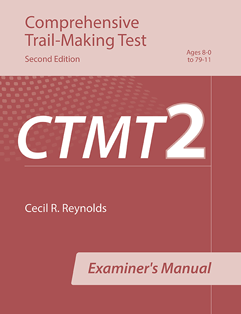Please specify the quantity of product(s).



Comprehensive Trail-Making Test Second Edition (CTMT-2)
| Item | Product | Price | QTY |
|---|---|---|---|
| 35742 | Comprehensive Trail-Making Test Second-Edition (CTMT-2) Kit | $183.00 | |
| 35742R | CTMT-2 Record Forms, Pk/10 | $85.00 | |
| 35724M | CTMT-2 Examiner's Manual | $87.00 |
Test Executive Functions and Planning in Culturally-Neutral Manner
Cecil R. Reynolds, PhD
The CTMT2 is a standardized assessment that uses five visual search and sequencing tasks, called trails, that are heavily influenced by attention, concentration, resistance to distraction, and cognitive flexibility (or set-shifting). The basic task of the trails is to connect a series of stimuli (numbers, expressed as numerals or in word form, and letters) in a specified order as quickly as possible.
The test’s primary uses include the evaluation and diagnosis of brain injury and other forms of central nervous system compromise. Other purposes include detection of frontal lobe deficits; problems with psychomotor speed, visual search and sequencing, and attention; and impairments in set shifting. Neuropsychologists; clinical, counseling, school, and pediatric psychologists; occupational therapists; speech and language professionals; physical therapists; and others interested in objective testing of functionality in brain–behavior relationships would benefit from using the CTMT2.
Features and benefits
- An updated normative sample is reflective of 2017 U.S. Census data for ages 8 to 79 years.
- Includes two new composite indexes, Inhibitory Control (composed of Trails 1–3) and Set Shifting (Trails 4–5). These indexes add clinical richness and assist both clinicians and researchers in evaluating the source and implications of low scores.
- Includes validity data relating the CTMT2 to Wechsler intelligence scales’ indexes.
- Enhanced validity data related to CTMT2 performance of persons with traumatic brain injury and the degree of initial injury as measured by the Glasgow Coma Scale are added.
- Includes diagnostic accuracy analyses, which are considered the most rigorous techniques for establishing a test’s validity. These analyses involve the computation of sensitivity and specificity indexes and receiver operating characteristic/area under the curve (ROC/AUC) statistics.
Technical information
- Normed on a sample of 1,904 participants from 38 states.
- Raw scores are converted to T scores having a mean of 50 and a standard deviation of 10.
- The Examiner’s Manual includes a discussion of the test’s theoretical and research-based foundation, standardization, administration and scoring procedures, normative tables, and extensive reliability and validity data.
- Internal consistency reliability coefficients are .89 for the Inhibitory Control Index, .79 for the Set-Shifting Index, and .92 for the Total Composite Index.
- Validity studies demonstrate the test’s ability to differentiate participants with a history of traumatic brain injury from those without. Specifically, a Total Composite Index (TCI) of 46 resulted in a sensitivity of .73, a specificity of .71, and a ROC/AUC of .82.